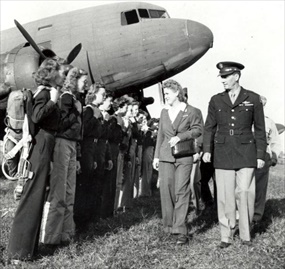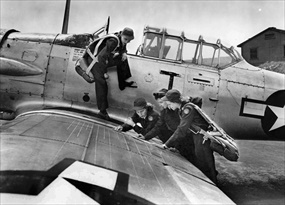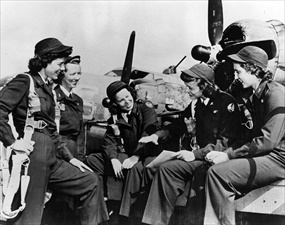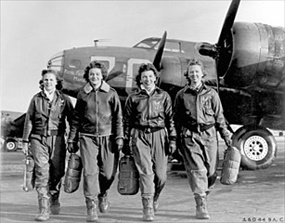WOMEN AIRFORCE SERVICE PILOTS RECOGNIZED IN CAPITOL CEREMONY
Capitol Hill, Washington, D.C. • March 10, 2010
On this date in 2010, 300 surviving members of the all-volunteer Women Airforce Service Pilots accepted Congressional Gold Medals in a ceremony at the U.S. Capitol. Six-and-a-half decades after the end of World War II, the first women to fly American military aircraft were officially recognized for their service by a grateful nation.
Better known by their nickname WASPs, these airwomen who answered their country’s call of duty numbered roughly 1,100. Although they were attached to the United States Army Air Forces, these pioneering women aviators were actually civilians who were federal civil service employees and therefore had no military standing. Oddly, these women were pretty much forced to wing it on their own, first starting with paying for their own uniforms, room and board, and pilot training and ending with paying their way home after discharge or for their own funeral, burial, and coffin upon which no American flag could be draped because the deceased (38 WASPs) were not military personnel. Incredibly, more than 25,000 women applied for flight training, 1,830 were accepted, of which 1,074 successfully completed the 21‑to-27 weeks of training at the all-male U.S. Army Air Forces flight school. On November 16, 1942, the first class of 29 women pilots reported for training.
WASP started out as 2 separate organizations. In the summer of 1941 2 women aviators, Nancy Harkness Love and Jacqueline “Jackie” Cochran, independently submitted proposals to Gen. Henry “Hap” Arnold, Chief of U.S. Army Air Forces, to allow for women pilots in noncombat missions to free up scarce male pilots for combat roles. Their plan was for qualified female pilots to ferry aircraft from factories to military bases and also pilot towing planes, i.e., planes that towed targets for live antiaircraft practice for men on the ground. (Some of the towing planes were riddled in live practice.) The first set of women pilots to take flight—this on September 10, 1942—belonged to the Women’s Auxiliary Ferry Squadron (WAFS) under Nancy Harkness Love. Five days later Cochran’s proposal to create the Women’s Flying Training Detachment (WFTD) to train more women to ferry aircraft was accepted by Arnold. In August 1943 the 2 organizations were merged at Arnold’s insistence, with Cochran to direct the new Women Airforce Service Pilots and Love retaining charge of WASP ferrying operations.
Eighteen groups of airwomen enrolled in the WASP training program before it was dissolved on December 20, 1944. The program included 4 months of training in flying “the Army way” by U.S. Army Air Forces instructors at Avenger Field in Sweetwater, Texas. Although female aviation cadets were not trained to fly in combat zones, their course of instruction was essentially the same as male cadets, the major exception being gunnery training. The percentage of female aviators failing USAAF military flight training was comparable to that of male cadets.
Stationed at 122 air bases across the U.S. in 6 ferrying groups, women of WASP flew over 60 million miles, chiefly ferrying planes from factories to airfields, delivered 12,652 aircraft of 78 different types, and transported every type of cargo. WASPs flew 80 percent of all ferried aircraft (the women flight-tested each one first) and freed about 900 male aviators for combat duty. Ironically, these veteran airwomen who had sacrificed and achieved so much during America’s wartime hour of need were prohibited from piloting aircraft in the postwar armed services. They worked hard to be recognized and rewarded for their wartime heroism and achievements, so quickly forgotten in peacetime, and they continued to work hard for decades fighting gender discrimination and prejudice in the U.S. military and negative public opinion. Today the granddaughters of these pioneering airwomen proudly serve in air wings of all branches of the U.S. armed forces and have done so since 1974 (Army and Navy), 1976 (Air Force), and 1977 (Coast Guard).
WASPs: The Brave Airwomen Who Winged It in World War II
 |  |
Left: Jacqueline Cochran, founder of the Women’s Flying Training Detachment (WFTD), reviews a line of women pilots who were nicknamed “Woofteddies” based on their unit’s acronym. Cochran is accompanied by a U.S. Army Air Forces officer at an unnamed airfield, though it was likely Avenger Field in Sweetwater, Texas. WASP applicants had to have a pilot’s license before entering the service; however, upon graduation the women were retrained to fly according to U.S. military regulations by USAAF instructors. After completing 4 months of military flight training, the pilots earned their wings and joined the first sets of women to fly American military aircraft.
![]()
Right: Four WASPs view an aerial chart on the wing of a North American AT‑6 Texan trainer. WASP recruits had have a high school diploma, be between 21 and 35 years old, be in good health and in possession of a commercial flying license, have 35 hours of flight time, and stand at least 5 feet 2 inches/157 cm tall. Over 99 percent of the trainees were white women, although a few applicants were African Americans who were rejected in the final interview.
 |  |
Left: WASP pilots relaxing on an unnamed air force base (probably Lockbourne Air Force Base in Ohio), where they trained to ferry 3‑engine Boeing B‑17 Flying Fortresses. In ferrying aircraft from location to location, women aviators occasionally had to touch down to use a restroom before reaching their destination because the military aircraft they ferried had no toilet facilities reserved for females. For a time WASPs were grounded during their menstrual periods because male commanders believed airwomen were “less efficient during menses.” Some restaurants refused service to WASPs because they were wearing pants.
![]()
Right: Four WASP pilots at the 4-engine flight school at Lockbourne Air Force Base, Ohio. They are Frances Green, Margaret (Peg) Kirchner, Ann Waldner, and Blanche Osborn. Thirty-three years later, in November 1977, President Jimmy Carter signed a bill granting veteran status and benefits to surviving WASPs. Finally female aviators were treated and respected for their flying abilities just like their male counterparts in the U.S. Army Air Forces Ferry Command to which future U.S. Senator Barry Goldwater of Arizona was assigned. But seriously, their flying abilities were long known before this photograph was taken in 1944. Maj. Gen. Curtis LeMay passed up the chain of command the grousing of his pilots over the difficulty of flying the new and advanced Boeing 4‑engine bomber, the B‑29 Superfortress. Gen. Arnold instructed Col. Paul Tibbets, the test pilot for Boeing’s B‑29 program, to recruit 2 WASPs, who were given 3 days training on the B‑29, to demonstrate that even women with less than a half week of training could fly the monster temperamental aircraft. After the airwomen’s successful demonstration flight, LeMay’s shamed the men, which stopped their grousing. Arnold, speaking to 71 graduates of the final WASP training class on December 7, 1944, said: “[W]e can come to only one conclusion. . . . It is on the record that women can fly as well as men.”
For the Love of Country: Women Airforce Service Pilots (WASP) in World War II
![]()

 History buffs, there is good news! The Daily Chronicles of World War II is now available as an ebook for $4.99 on Amazon.com. Containing a year’s worth of dated entries from this website, the ebook brings the story of this tumultuous era to life in a compelling, authoritative, and succinct manner. Featuring inventive navigation aids, the ebook enables readers to instantly move forward or backward by month and date to different dated entries. Simple and elegant! Click
History buffs, there is good news! The Daily Chronicles of World War II is now available as an ebook for $4.99 on Amazon.com. Containing a year’s worth of dated entries from this website, the ebook brings the story of this tumultuous era to life in a compelling, authoritative, and succinct manner. Featuring inventive navigation aids, the ebook enables readers to instantly move forward or backward by month and date to different dated entries. Simple and elegant! Click 











